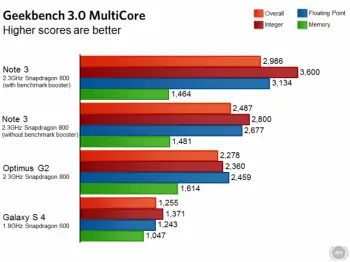
Samsung Galaxy Note 3 is also using benchmark boosting software to inflate scores
Here at Phandroid, we never put much emphasis on benchmarks. While sometimes a fun way to measure general device performance, they don’t really give us an accurate measure of real world speed from a device. More than often benchmarks are simply a tool for fanboys to tout their device superiority over another — and we think that’s super lame, bros.
It wasn’t too long ago it was discovered that Samsung was inflating benchmarks scores for the Samsung Galaxy S4. Using a special benchmark boosting app found inside their custom software, Samsung was able to make the S4 fire on all cylinders. This caused the GPU to hit a frequency outside of what was available to the end user when using the device for normal things (like playing a video game). While not completely deceptive, it was a little misleading and we had little reason to believe this would change in the Samsung Galaxy Note 3. Looks like we were right.
When comparing scores on the LG G2 and Samsung Galaxy Note 3 — 2 devices using the same Snapdragon 800 SoC — ArsTechnica discovered the Note scoring abnormally high for a phone with the same processor. Lo and behold, Samsung was up to their same old tricks. After diving a little deeper, some line of code was discovered as the culprit and causing the Note 3 to operate in “high-power CPU mode” only when a benchmarking app is opened.
To get around this and measure performance that is actually offered to the average Note 3 users, Ars renamed Geekbench so that it would fly under the radar of Samsung’s benchmark boosting software. It’s ironic that even without the benchmark boosting, the Note 3 still outperformed the LG G2, (again, both devices equipped with the same SoC), so it appears there was little reason for Samsung to do this unless they’re prepping for the unforeseen Android competition in the future.
Where as Samsung’s official stance on the S4’s benchmark boosting app is that it was also available on a variety of Samsung-made system apps, it appears the Note 3’s is reserved exclusively for benchmarks. No gallery, no video player, no browser. Whether or not Samsung is being shady in providing users with the highest possible performance of their hardware — despite not being available in normal use — is up to you.